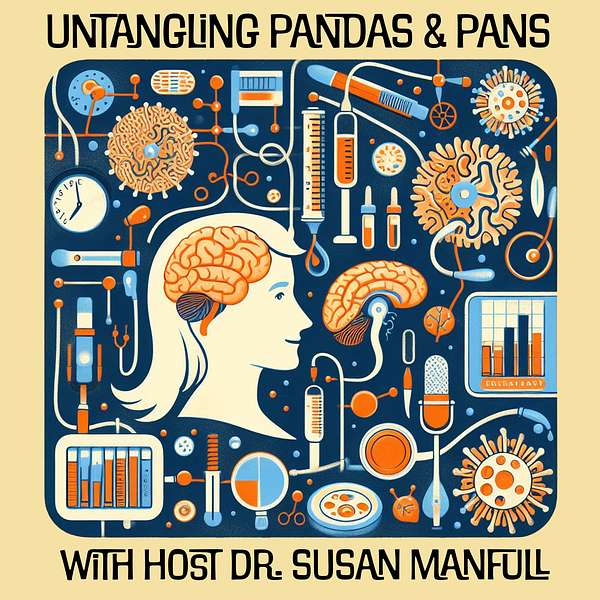
Untangling PANDAS & PANS: Conversations about Infection-Associated, Immune-Mediated Neuropsychiatric Disorders
Hello and welcome to Untangling PANDAS & PANS, a podcast about two relatively unknown medical disorders characterized by the sudden and dramatic onset of obsessions and compulsions, vocal or motor tics, or restricted eating behavior -- and a whole host of other symptoms -- following strep or other bacterial or viral infection. Sometimes overnight. I have the privilege of interviewing some of the top researchers and clinicians in the rapidly growing field of Infection-Associated, Immune-Mediated Neuropsychiatric Disorders. That’s a mouthful of words that encompasses the strangely named disorders, PANDAS and PANS.
My name is Dr. Susan Manfull. I am a social psychologist, the Executive Director of The Alex Manfull Fund, and the mother of Alex Manfull, who died at 26 years old due to PANDAS, a neuropsychiatric disorder my husband and I knew next to nothing about, certainly not that our daughter could die from it.
PANDAS is an acronym for “Pediatric Autoimmune Neuropsychiatric Disorder Associated with Streptococcus.” This disorder, first defined in 1998 at the National Institute of Mental Health, describes the acute and dramatic onset of obsessions and compulsions and/or motor or vocal tics as well as a whole host of neuropsychiatric symptoms in temporal association to a Group A streptococcal infection. PANS, which stands for Pediatric Acute-onset Neuropsychiatric Syndrome, refers to a similar symptom presentation -- with obsessions and compulsions or restricted eating being the cardinal symptoms -- due to a broader category of triggers (typically bacterial or viral infections). Both are thought to stem from a dysregulated immune system, probably leading to an over-production of autoantibodies and concomitant excess brain inflammation, particularly in the basal ganglia.
Symptoms vary from person to person and range in severity from mild to severe, and generally have a relapsing and remitting course. With early recognition and correct treatment, these disorders can be successfully treated. Today, it is no longer viewed as a diagnosis limited to the pediatric population.
Please stay tuned after each episode to listen to a one-minute public service announcement about PANDAS & PANS and The Alex Manfull Fund. To learn more, please visit our website: TheAlexManfullFund.org.
This content is not intended to be a substitute for professional medical advice, diagnosis, or treatment. Always seek the advice of your physician or other qualified healthcare provider with any questions you may have regarding a medical condition.
Untangling PANDAS & PANS: Conversations about Infection-Associated, Immune-Mediated Neuropsychiatric Disorders
S2 E10: Dr. Juliette Madan Explains the Importance of Epidemiological Research on PANDAS & PANS
Juliette C. Madan, MD, MS wears many hats. Dr. Madan is an Associate Professor of Pediatrics, Psychiatry, Epidemiology, and Quantitative Biomedical Data Science at Geisel School of Medicine at Dartmouth. She is the Clinical Director of the Children’s Environmental Health and Disease Prevention Research Center within Geisel and Dartmouth Hitchcock Medical Center. She is widely recognized for her research in understanding the intestinal microbiome’s role in health and disease and in interventions such as nutritional, probiotic regimens, and fecal matter transplant.
My relationship with Dr. Madan grew out of her role as co-founder of the Psychiatry Immunology and Neurology Group (known as PING) which is now named the Neuroimmune Psychiatric Disorders (NIPD) Clinic, one of only a handful of clinics in the nation devoted to treating PANDAS and PANS in children and adults. That was founded in 2019. Today, she and Dr. Richard Morse, a neurologist with whom she founded PING, are the co-chairs of The Alex Manfull Fund Scientific and Medical Advisory Board
I could have talked to Dr Madan about a multitude of subjects but, for this interview I asked her to wear her Epidemiology hat. (She promised to return to discuss other areas).
Current estimates of the incidence of PANDAS/PANS varies widely from 1 in 46,000 to as high as 1 in 200. The latter figure is bandied around but it is not based on research, epidemiological or otherwise. Dr Madan discusses her own recent (2023) research with Dr. Ellen Wald, a highly respected pediatric infectious disease physician, and others on the prevalence of PANDAS and PANS. Because there were many limitations in that study, she and Dr. Wald are about to conduct an (NIH-supported) epidemiological study to answer the prevalence question using a different methodology,
Dr Madan is a graduate of Brown University School of Medicine, after which she completed a fellowship program in neonatal-perinatal medicine at Tufts University and while at Tufts, completed a master's degree in clinical and translational research.
When Dr. Madan is not in her clinic or her lab, look for her on the Connecticut River as she is a passionate rower. She also manages to find time with her ducks and chickens!
NOTE: My conversation with Dr. Madan was recorded prior to the December 16, 2024 release of the preliminary clinical report on PANS by The American Academy of Pediatrics (AAP).
Disclaimer: The views and opinions expressed in this program are those of the speakers and do not necessarily reflect the views or positions of any entities they represent.
Credits: Music by Kingsley Durant from his "Convertible" album
To learn more about PANDAS and PANS and The Alex Manfull Fund, visit our website: TheAlexManfullFund.org
Follow us on:
Facebook
Instagram
LinkedIn
